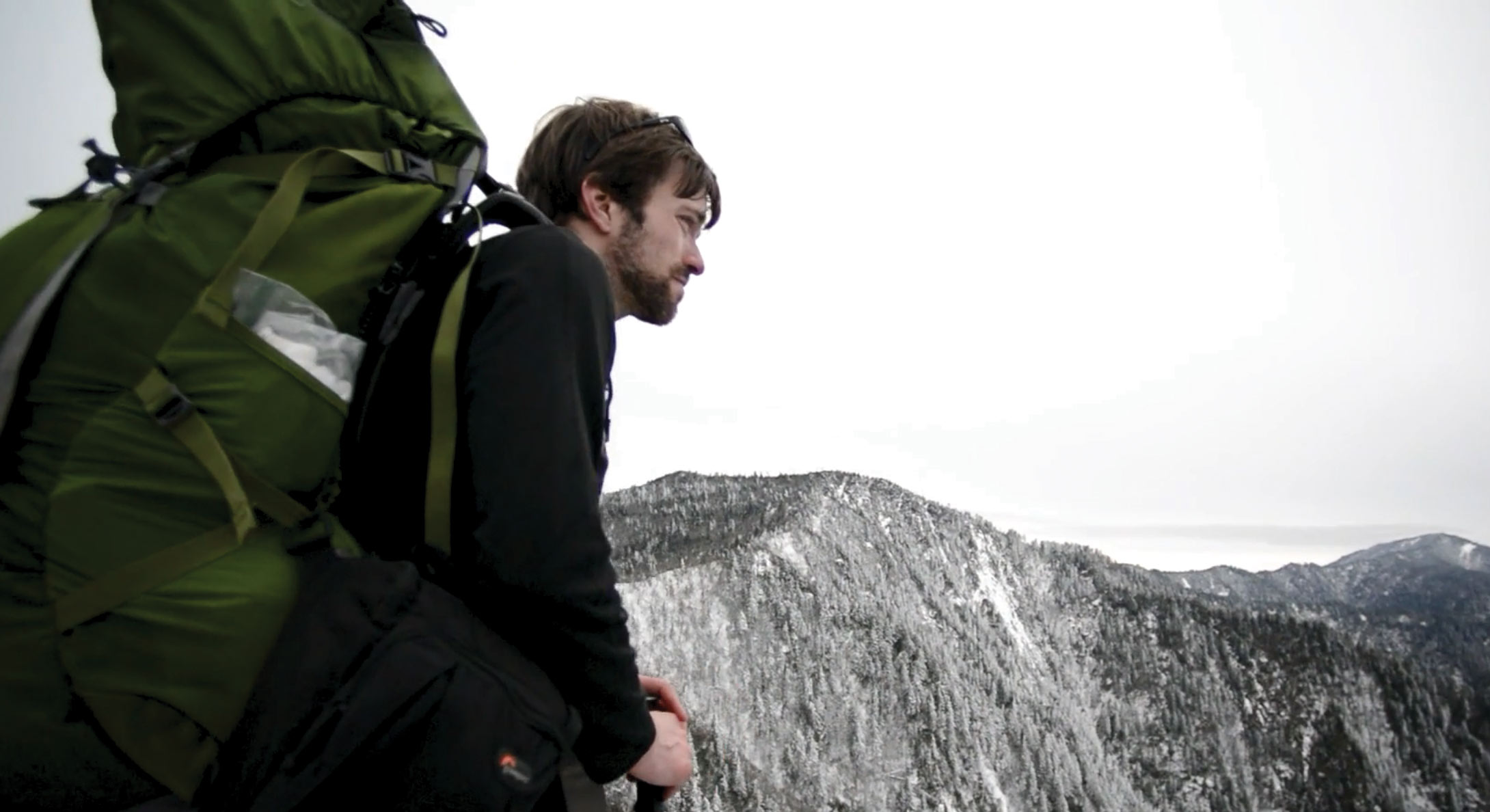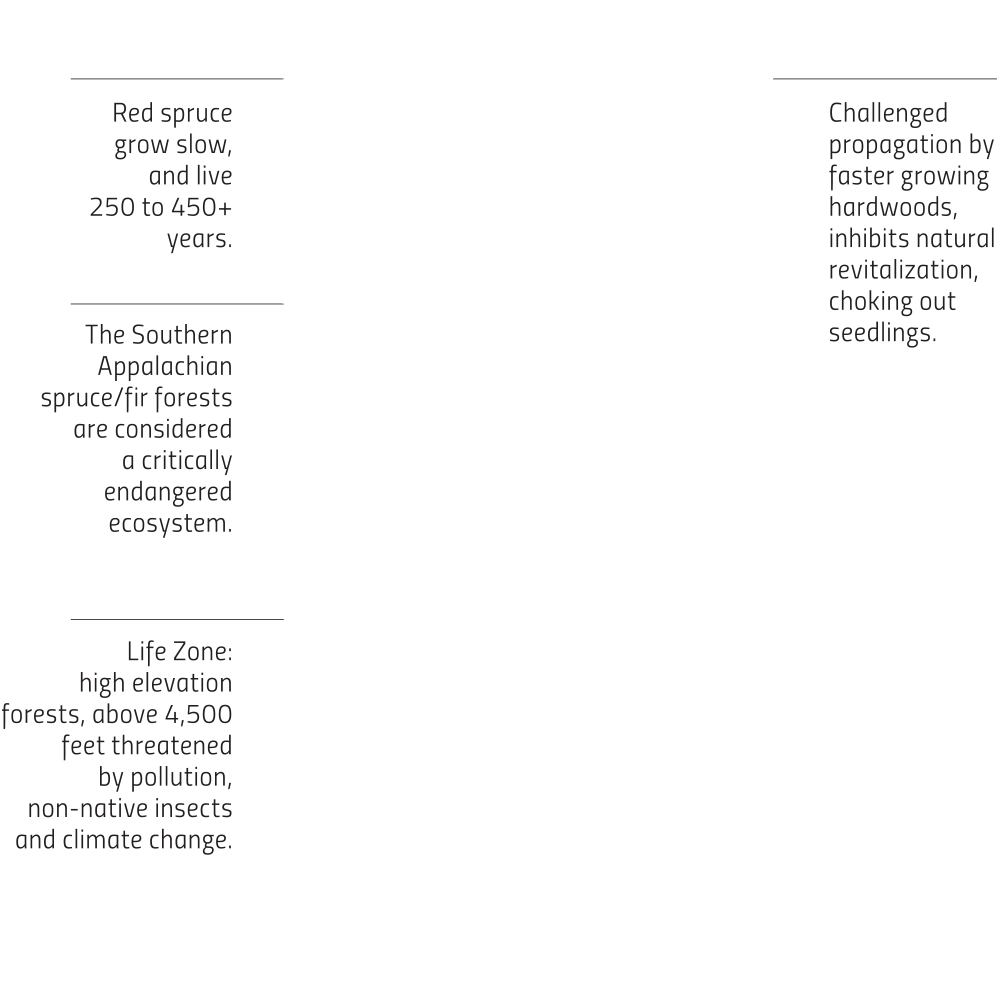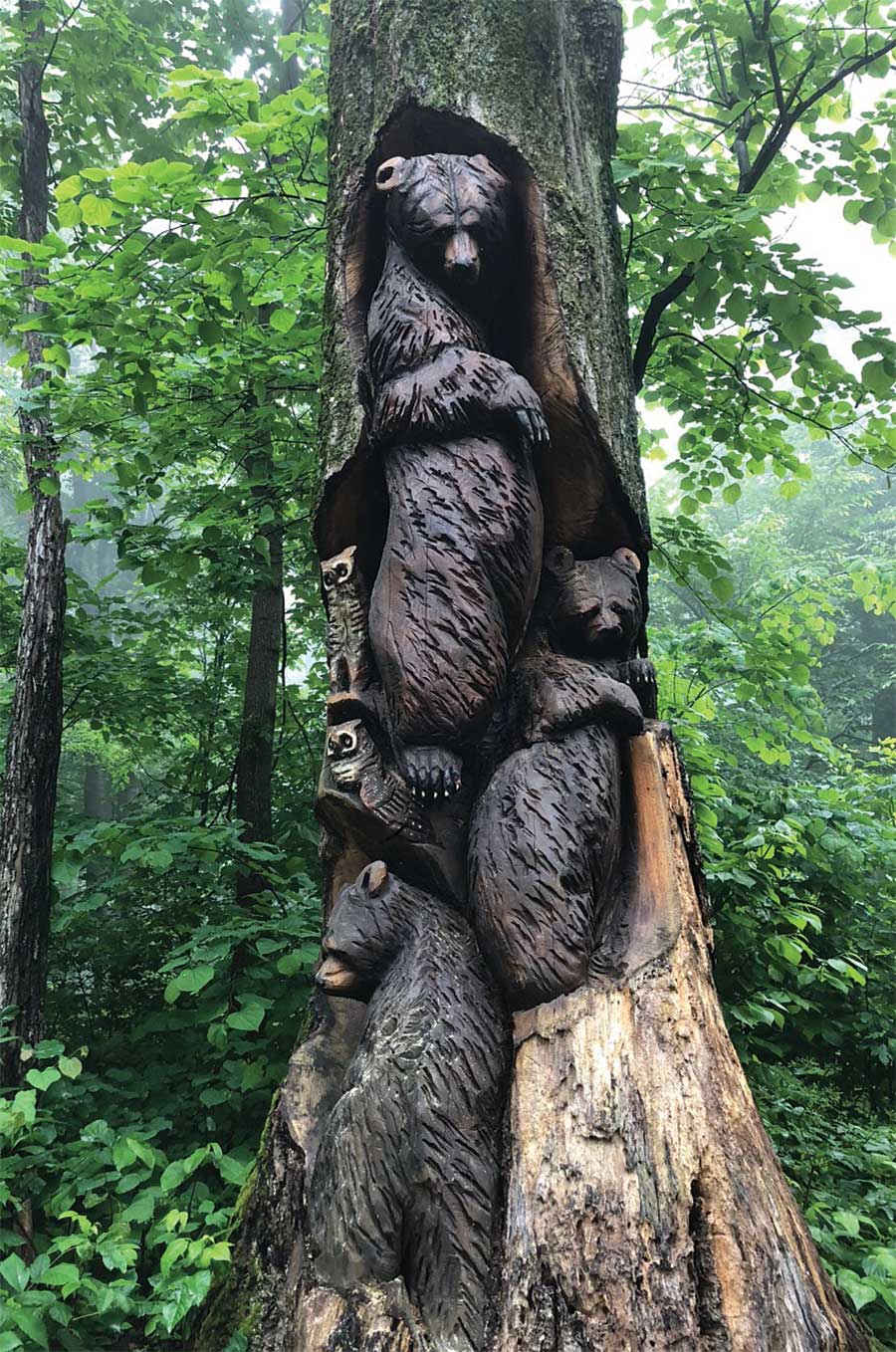
WILD
EAST:
The importance of the
Appalachian Trail in
the eastern United States
WILD
EAST:
The importance of the
Appalachian Trail in
the eastern United States
WILD
EAST:
The importance of the
Appalachian Trail in
the eastern United States

The Trail as Skyway
and Home for Birds
A Wonder in Winter:
Bundle Up and Enjoy a
Cool Hike

The Trail as Skyway
and Home for Birds
A Wonder in Winter:
Bundle Up and Enjoy a
Cool Hike

The Trail as Skyway
and Home for Birds
A Wonder in Winter:
Bundle Up and Enjoy a
Cool Hike
ON THE COVER
Morning Light from Mount
Cammerer — Great Smoky
Mountains, North Carolina/
Tennessee. By Steven Yocom
ON THE COVER
Morning Light from Mount
Cammerer — Great Smoky
Mountains, North Carolina/
Tennessee. By Steven Yocom

Suzanne Dixon / President & CEO
Stacey J. Marshall / Vice President of Finance & Administration
Elizabeth Borg / Vice President of Membership and Development
Laura Belleville / Vice President of Conservation & Trail Programs
Lynn Davis / Vice President of Strategic Communications
Cherie A. Nikosey / Chief of Staff
Brian B. King / Publisher
Wendy K. Probst / Editor in Chief
Traci Anfuso-Young / Graphic Designer
Jordan Bowman / Communications Manager
Laurie Potteiger / Information Services Manager
Brittany Jennings / Proofreader
The Appalachian Trail Conservancy’s mission is to preserve and manage the Appalachian Trail — ensuring that its vast natural beauty and priceless cultural heritage can be shared and enjoyed today, tomorrow, and for centuries to come.
Sandra Marra / Chair
Greg Winchester / Vice Chair
Edward R. Guyot / Secretary
Mary Higley / Treasurer
Colin Beasley
Beth Critton
Grant Davies
Shalin Desai
Norman P. Findley
Thomas L. Gregg
Daniel A. Howe
Robert Hutchinson
James LaTorre
Colleen Peterson
Rubén Rosales
Hon. C. Stewart Verdery, Jr. / Chair
Stephanie Martz / Co-Chair
Diana Christopulos
Constance I. DuHamel
Lisa Koteen Gerchick
Jessica Herrera-Flanigan
R. Michael Leonard
Robert Rich
Thomas Torrisi
Sara Hazelwood Yanes
For membership questions or to become a member, call: (304) 885-0460
![]()
[email protected]
A.T. Journeys is published four times per year. Advertising revenues directly support the publication and production of the magazine, and help meet Appalachian Trail Conservancy objectives. For more information and advertising rates, visit: appalachiantrail.org/atjadvertising
The Appalachian Trail Conservancy’s mission is to preserve and manage the Appalachian Trail — ensuring that its vast natural beauty and priceless cultural heritage can be shared and enjoyed today, tomorrow, and for centuries to come.
Sandra Marra / Chair
Greg Winchester / Vice Chair
Edward R. Guyot / Secretary
Mary Higley / Treasurer
Colin Beasley
Beth Critton
Grant Davies
Shalin Desai
Norman P. Findley
Thomas L. Gregg
Daniel A. Howe
Robert Hutchinson
James LaTorre
Colleen Peterson
Rubén Rosales
Hon. C. Stewart Verdery, Jr. / Chair
Stephanie Martz / Co-Chair
Diana Christopulos
Constance I. DuHamel
Lisa Koteen Gerchick
Jessica Herrera-Flanigan
R. Michael Leonard
Robert Rich
Thomas Torrisi
Sara Hazelwood Yanes
Observations, conclusions, opinions, and product endorsements expressed in A.T. Journeys are those of the authors and do not necessarily reflect those of members of the board or staff of the Appalachian Trail Conservancy.
A.T. Journeys is published on Somerset matte paper manufactured by Sappi North America mills and distributors that follow responsible forestry practices. It is printed with Soy Seal certified ink in the U.S.A. by Sheridan NH in Hanover, New Hampshire.
A.T. Journeys (ISSN 1556-2751) is published quarterly for $15 a year by the Appalachian Trail Conservancy, 799 Washington Street, Harpers Ferry, WV 25425, (304) 535-6331. Bulk-rate postage paid at Harpers Ferry, West Virginia, and other offices. Postmaster: Send change-of-address Form 3575 to A.T. Journeys, P.O. Box 807, Harpers Ferry, WV 25425.



Kim O’Connell writes about science, history, conservation, and sustainability for a range of national publications. She has served as a writer-in-residence at Acadia and Shenandoah national parks and teaches in the Johns Hopkins University Master’s in Science Writing program. “As a writer, I love how metaphorical the Appalachian Trail is — how it offers important life lessons about taking things one step at a time, being brave enough to venture into new territory, and trusting a long and winding path,” she says. “I’m always excited to get back on the Trail and learn those lessons all over again.”

In this issue, we present the eye-catching artwork of Dr. Tyler Nordgren, an unusually gifted artist, astronomer, and author. Tyler is well-known for his contemporary series of “Milky Way” posters for dozens of national parks and his series on the 2017 eclipse, which are now part of the Smithsonian collection. His commissioned artwork of the Appalachian Trail presents some of the Trail’s attributes in a fresh new way, reminiscent of vintage “See America” posters. “We are driven to conserve what we value, and we value what we know,” says Tyler. “For me, this project helps share the wild beauty of the eastern U.S. and the need to protect and conserve it just as we would the canyons, arches, and mountains out west.”

As a child, Marina Richie watched raptors at Hawk Mountain Sanctuary in Kittatinny, Pennsylvania with her father Dave Richie — a former National Park Service official who played an important role in protecting the Trail. Later, Marina backpacked the Monson to Katahdin section of the Trail with him in Maine. “Every bird of the A.T. is magnificent — from the cerulean warbler winging from the Appalachians to the Andes, to the pileated woodpecker drumming on a tree,” she says. “My father had this knack for finding rejuvenation in bird song no matter how arduous his A.T. hike. Writing this piece connected me even more deeply to him, and to the grassroots legacy of the A.T. that gives me hope for the future of our imperiled birds.”

The A.T. wove its way into Amanda Wheelock’s life when she moved from Georgia to New Hampshire to attend Dartmouth College. There, she worked on a Trail crew, taught backpacking, and hiked from Hanover to Moosilauke because it was “tradition.” She quickly discovered that her love of long-distance trails was more than just a college fling. Amanda now works for the Continental Divide Trail Coalition and stays connected to her first love by volunteering on the Appalachian Trail Conservancy’s Next Generation Advisory Council. “Writing about winter hiking toward the end of a year jam-packed with change gave me a welcome opportunity to look back at a wonderful weekend spent on the A.T.”
The Heart of the Wild East
The Appalachian Trail Conservancy (ATC) is off to a great start this year in thinking creatively, with an eye on the future. We’re launching “Wild East,” a powerful public outreach initiative intended to increase support for the Trail and the lands that surround it. You, and hopefully millions of other people, are going to hear us talk about how the Appalachian Trail is the heart of an important corridor of open space in the eastern United States — open space that astonishingly remains intact, stretching nearly 2,200 miles, open space that needs attention and your support.
Just as the West has its allure of scenic vistas, starry skies, and towns of character, so does the Trail and its adjoining lands. The ATC is going to be talking about how the Wild East is every bit as important as the iconic, well-known national parks in the West. And how we now, urgently, need to make certain the future of the Trail is expansive, not limited.

Lee Sneed
Central, South Carolina

Illustration By Tyler Nordgren



Information courtesy the National Park Service


It’s not only the particulars of pursuing Leave No Trace training and education, promoting flip flop thru-hikes, and attempting outside-the-box approaches that help conserve the Trail and sustain communities that make Deb Coleman such an exemplary Appalachian Trail Conservancy volunteer. It’s her willingness and eagerness to try new things, from doing Trail maintenance, to joining a local wilderness first responder rescue group, to trying corridor boundary maintenance. “If just one in 100 hikers did half of what Deb does,” says the ATC’s information services manager Laurie Potteiger, “we’d be on our way to cultivating our next generation of leaders.”
your own A.T. tribute story, and read others at appalachiantrail.org/tributegarden
The Appalachian Trail Conservancy (ATC) announces that the A.T. Tribute Garden — located at ATC’s headquarters in Harpers Ferry, West Virginia — is complete.
Thanks to the generosity of more than 600 donors who purchased engraved bricks, boulders, benches, and other items, the ATC created a lovely and peaceful place that celebrates and remembers those who have walked the Appalachian Trail, helped protect it, and have been inspired by the longest, continuous footpath in the world.

The Appalachian Trail Conservancy (ATC) announces that the A.T. Tribute Garden — located at ATC’s headquarters in Harpers Ferry, West Virginia — is complete.
Thanks to the generosity of more than 600 donors who purchased engraved bricks, boulders, benches, and other items, the ATC created a lovely and peaceful place that celebrates and remembers those who have walked the Appalachian Trail, helped protect it, and have been inspired by the longest, continuous footpath in the world.

A Lifetime of Trail Building
By Hawk Metheny

Bob at the Great Wall in China (during a visit to explain Trail design)
The Appalachian Trail Community lost a long-time supporter and trusted friend last October. Known to many of us from Georgia to Maine and beyond, Bob Proudman passed away while with his family on October 18 after a brief and courageous struggle with cancer.

congressional update
Find out what’s happening on Capitol Hill — and how it will affect the Trail.
For more information visit: appalachiantrail.org/takeaction
A three-year relocation of the Trail in central Virginia was just completed at the end of 2018, replacing a steep and slippery scramble with a gently-graded switchback. The final half-mile of the northbound ascent of Sinking Creek Mountain was identified as a problem over a decade ago, since steep alignment made the Trail hazardous in wet conditions. But finding a new route was complicated by a relatively narrow corridor of national forest land and an abundance of rock fields. The new switchback fits just within the corridor, and features over 200 rock steps and many large stone crib walls built to last for generations. An observant hiker can enjoy a challenging but more enjoyable climb, as well as the beauty of the durable, technical stone structures.
More than 100 volunteers from the Appalachian Trail Conservancy’s (ATC) Konnarock Trail Crew and the Roanoke A.T. Club contributed almost 4,000 hours to complete the relocation. Volunteers from the nearby Natural Bridge A.T. Club and the Outdoor Club at Virginia Tech pitched in too, especially for the final “Special Forces” push to open the new section in December. Relocations like this are integral to the ever-evolving A.T.
A three-year relocation of the Trail in central Virginia was just completed at the end of 2018, replacing a steep and slippery scramble with a gently-graded switchback. The final half-mile of the northbound ascent of Sinking Creek Mountain was identified as a problem over a decade ago, since steep alignment made the Trail hazardous in wet conditions. But finding a new route was complicated by a relatively narrow corridor of national forest land and an abundance of rock fields. The new switchback fits just within the corridor, and features over 200 rock steps and many large stone crib walls built to last for generations. An observant hiker can enjoy a challenging but more enjoyable climb, as well as the beauty of the durable, technical stone structures.
More than 100 volunteers from the Appalachian Trail Conservancy’s (ATC) Konnarock Trail Crew and the Roanoke A.T. Club contributed almost 4,000 hours to complete the relocation. Volunteers from the nearby Natural Bridge A.T. Club and the Outdoor Club at Virginia Tech pitched in too, especially for the final “Special Forces” push to open the new section in December. Relocations like this are integral to the ever-evolving A.T.



The fluting notes of a wood thrush serenade your one-pot dinner. A barred owl hoots “who cooks for you” in the night. A loon’s wail coils around your heart on a Maine lake. Wherever you are on the Appalachian Trail, birds offer sweet companionship. Yet, as hiker numbers soar, bird populations tumble.
More than half of North America species are experiencing major declines. We have a few billion less birds than 40 years ago. In one drastic example, the golden-winged warbler nests in multiple places along the A.T., including the Roan Highlands, where its numbers have plummeted by a staggering 98 percent. Within this sobering news, the A.T. shines with the promise of protection and ecological restoration. For instance, the Appalachian Trail Conservancy’s (ATC) habitat work on behalf of the golden-winged warbler is leading to an uptick in nesting birds, while serving hikers with more expansive views. The ATC also partners with other groups to conserve the warbler’s critical winter home in Columbia and Venezuela. This work across international boundaries will help to ensure the survival of this species.


“Awesome!” she replied. “And here I thought January camping would be a tough sell.”
Chloë works for the Appalachian Trail Conservancy (ATC) and needed to hit the Trail to scout a route for a “How to Hike the A.T.” backpacking course she’d be leading that spring, but I had my own motivations for joining her. I had just found out that I would be moving to Colorado in three weeks. While I was excited for all the skiing I would soon be doing, I knew that my hiking boots would get tucked away in a corner of my closet for the next few months. The mountains of western North Carolina had been my home for almost four years, and I couldn’t think of a better way to say goodbye for now than to spend a weekend exploring a new section of that familiar white-blazed Trail. So what if it was January?

“Awesome!” she replied. “And here I thought January camping would be a tough sell.”
Chloë works for the Appalachian Trail Conservancy (ATC) and needed to hit the Trail to scout a route for a “How to Hike the A.T.” backpacking course she’d be leading that spring, but I had my own motivations for joining her. I had just found out that I would be moving to Colorado in three weeks. While I was excited for all the skiing I would soon be doing, I knew that my hiking boots would get tucked away in a corner of my closet for the next few months. The mountains of western North Carolina had been my home for almost four years, and I couldn’t think of a better way to say goodbye for now than to spend a weekend exploring a new section of that familiar white-blazed Trail. So what if it was January?




Chris has also produced a beautiful and calming short video for the ATC featuring winter hiking and spring thaw. Visit: appalachiantrail.org/winterontheat, and immerse yourself in the virtual experience of winter on the Trail.
Chris and his wife, “Sunshine,” live in Black Mountain, North Carolina with their young son and infant daughter. Chris’ award-winning production company, Horizonline Pictures, produced ATC’s exceptional myATstory video series which can be viewed at: myATstory.org.
WINTER SUNRISE FROM MOUNT CAMMERER FIRE TOWER
“EVERY YEAR, WHEN WE GET A GOOD SNOW, I head out into the thick of it. Winter imagery can be fleeting in the southern Appalachians, so it’s important to get out and stay out before all the fresh snow blows off the trees. For this particular storm, the eastern edge of the Smokies was going to get a good bit of snow from the west. We set our sights on Mount Cammerer. I’d been eyeing that little fire tower for many years while driving I-40 home each week at my old job. We chose Davenport Gap as our starting point due to its easy access and close proximity to my cabin. As we started up, there was just a bit of snow, but by the time we crested the ridge the drifts were knee deep, the wind was howling, and we kept getting quick glimpses of stars above us as the storm made its way out. With the wind, it was easily zero degrees — we prayed that the tower would be unlocked so we could escape the cold and make a cup of coffee while awaiting the sunrise. Luck was on our side — fresh grounds in the AeroPress, a bagel with peanut butter and honey, and then it was time to get to work. The clouds cleared and the sun rose over fresh snow on the pines and distant mountains. It was a photographer’s dream. Sometimes I get shut out, stuck in a cloud, or the light is no good. But mornings like this I hold dear; they keep me going in hopes for the next one.” ~ Steven Yocum
WINTER SUNRISE FROM MOUNT CAMMERER FIRE TOWER
“EVERY YEAR, WHEN WE GET A GOOD SNOW, I head out into the thick of it. Winter imagery can be fleeting in the southern Appalachians, so it’s important to get out and stay out before all the fresh snow blows off the trees. For this particular storm, the eastern edge of the Smokies was going to get a good bit of snow from the west. We set our sights on Mount Cammerer. I’d been eyeing that little fire tower for many years while driving I-40 home each week at my old job. We chose Davenport Gap as our starting point due to its easy access and close proximity to my cabin. As we started up, there was just a bit of snow, but by the time we crested the ridge the drifts were knee deep, the wind was howling, and we kept getting quick glimpses of stars above us as the storm made its way out. With the wind, it was easily zero degrees — we prayed that the tower would be unlocked so we could escape the cold and make a cup of coffee while awaiting the sunrise. Luck was on our side — fresh grounds in the AeroPress, a bagel with peanut butter and honey, and then it was time to get to work. The clouds cleared and the sun rose over fresh snow on the pines and distant mountains. It was a photographer’s dream. Sometimes I get shut out, stuck in a cloud, or the light is no good. But mornings like this I hold dear; they keep me going in hopes for the next one.” ~ Steven Yocum

RED SPRUCE


ILLUSTRATION COURTESY BIODIVERSITY HERITAGE LIBRARY
RED SPRUCE
(Picea rubens) once thrived in the southern Appalachian’s iconic areas of Clingmans Dome, Mount Rogers, and Roan Mountain. These forests are now considered a critically endangered ecosystem.
Red spruce were heavily logged between 1905 and 1930, followed by wildfires, further drying the soils making conditions poor for germination. Hardwood species had the advantage (birch, cherry, maple) choking out spruce seedlings.
Reflections on A Winged Journey




 From left: Sunset from Bears Den Rocks. By Dean Clark; An elaborate carving greets visitors at Bears Den; Blackburn Trail Center is well-known for its hospitality to hikers. Photos by Laurie Potteiger
From left: Sunset from Bears Den Rocks. By Dean Clark; An elaborate carving greets visitors at Bears Den; Blackburn Trail Center is well-known for its hospitality to hikers. Photos by Laurie Potteiger





























